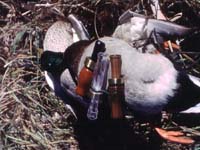
|
Features
|
|
|
|
Books
|
|
|
|
Fun & Games
|
|
|
|
Contact Us
|
|
|
John's Journal... Entry 73, Day 2
Acrylic vs. Wood Duck Calls
 EDITOR'S
NOTE: Brad Harris, vice president of public relations at Outland Sports,
the owners of Lohman and M.A.D. calls, is a hunting expert and a longtime
duck hunter. More than 26-million households across the nation watch Outland
Sports television show, "Outdoor Traditions with Brad Harris."
EDITOR'S
NOTE: Brad Harris, vice president of public relations at Outland Sports,
the owners of Lohman and M.A.D. calls, is a hunting expert and a longtime
duck hunter. More than 26-million households across the nation watch Outland
Sports television show, "Outdoor Traditions with Brad Harris."
Question: Brad, Outland Sports owns Lohman's Calls
and also has Big River waterfowl calls. You have a new duck call in the
Lohman call line. What is it called?
Answer: We have two new calls in the Lohman line -- the Marsh Master
calls. One is the Arkansas-style single reed, acrylic call with a pretty
brass band. It's a good high-ringing, long-range call that's great for
competition. The other one is built the same way, except it's a double
reed. The double-reed call has almost as much versatility as the single
reed. You can blow these calls, and if you're a novice, you won't squeal
it out. So these calls are good ones for a beginner or someone who really
wants to put a lot of air into a call.
 Question:
Are both calls made out of acrylic?
Question:
Are both calls made out of acrylic?
Answer: Yes, both are made out of acrylic.
Question: What's the advantage of acrylic over
wood?
Answer: You'll get some ring out of the acrylic call that you maybe
won't get out of the wood because of its density. That's probably the
biggest advantage. I like a wood call, and a wood call that's built well
is every bit as effective. To me, a wood call is hard to beat as far as
looks go. I love a real pretty wood call, but the acrylic is very durable
and also adds a little ring to those high-end calls, the Arkansas style
and calls like that.
 Question:
Acrylic is a relatively new material for duck calls. Is that the reason
more and more people are using acrylics? Are they easier to make? Why
do we see more people going to acrylic calls and away from wood calls?
Question:
Acrylic is a relatively new material for duck calls. Is that the reason
more and more people are using acrylics? Are they easier to make? Why
do we see more people going to acrylic calls and away from wood calls?
Answer: Acrylics are easier to make. You just build a mold and
mold them, whereas wood calls take quite a bit of machine work. Also,
you have to deal with defects in wood such as grainy wood, a knothole
or something like that. So your waste factor is probably a little higher
with wood. Acrylic is a whole lot easier once you build your mold and
get everything built right. Then you just kick out the parts. Wood takes
a little more of a hands-on touch. So that's why you see especially the
upstart companies using the acrylics. For the old companies like Lohman,
Faulk, etc. that have been around since the 1930s and 1940s, wood calls
are still their bread and butter in a lot of instances. Big River is another
company that has a fine selection of wood calls that are real pretty pieces
of work.
 Question:
Brad, the No. 1 problem most duck hunters have with their calls is the
reed sticking. What have you done to solve the problem of the reed sticking
or icing up?
Question:
Brad, the No. 1 problem most duck hunters have with their calls is the
reed sticking. What have you done to solve the problem of the reed sticking
or icing up?
Answer: Over the years, we have come up with a no-stick reed system
that has been incorporated into our Lohman Model 400 and 401 calls. We
undercut the surface of the tone chamber where the reed lies, which allows
the saliva and the moisture to drop away from the reed so the reed won't
cling to that surface and that has helped tremendously. With traditional
duck calls, you're going to have calls to hang up. That's why I always
have three or four calls around my neck. When I feel one tightening up,
then I just reach for another one, or I'll cup it real hard and hit it
hard with a burst of air and clear it. If the weather is really cold and
you get a lot of moisture in the call, it may hang up on you. So you need
to keep several calls with you to finish out the flight of ducks you're
working. Switch to another call. When they leave and you're picking up
ducks and having a cup of coffee, you can clean that call and it'll be
ready to go for the next flight.
Tomorrow: When to Use Different Types of Duck Calls
Check back each day this week for more about Brad Harris On Duck Hunting ...
Day 1 -General Duck-Hunting
Information
Day 2 -Acrylic vs. Wood Duck Calls
Day 3 -When to Use Different Types of Duck
Calls
Day 4 -Reading the Ducks
Day 5 -Hunting Ducks in High-Pressure Areas